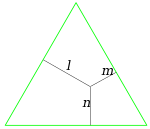Viviani's theorem

Viviani's theorem, named after Vincenzo Viviani, states that the sum of the distances from a point to the sides of an equilateral triangle equals the length of the triangle's altitude.
The theorem can be extended to equilateral polygons and equiangular polygons. Specifically, the sum of distances from a point to the side lines of an equiangular [or equilateral] polygon does not depend on the point.[1]
Proof
This theorem can be easily proven by comparing areas of triangles. Let ABC be an equilateral triangle where h is the height, and s is the length of each side. P is any point inside the triangle, and ℓ, m, n are the distances of point P from the sides. Then the area of triangle ABC is
and that is what we wanted.
Applications

Viviani's theorem means that lines parallel to the sides of an equilateral triangle give coordinates for making ternary plots, such as flammability diagrams.
More generally, they allow one to give coordinates on a regular simplex in the same way.
See also
References
External links
- Viviani's Theorem: What is it? at Cut the knot.
- Viviani's Theorem by Jay Warendorff, the Wolfram Demonstrations Project.



